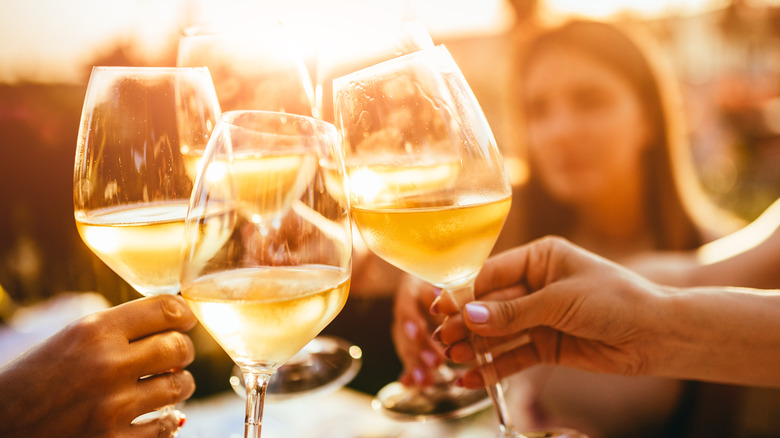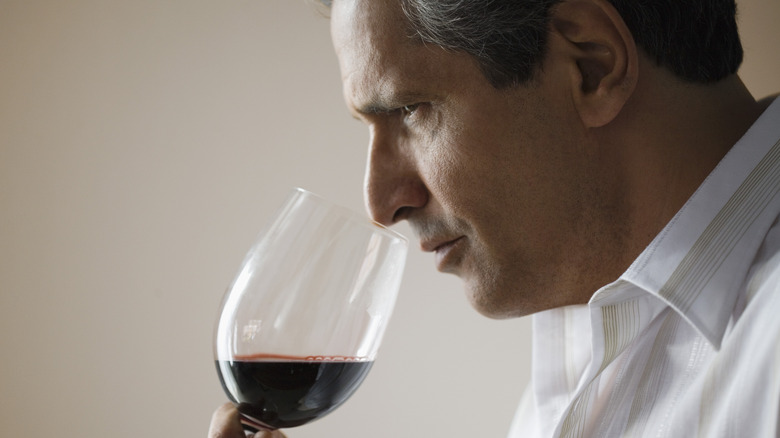How Many Glasses Of Wine Can You Expect To Come In A Bottle?
From reds to whites to rosés, the variety of flavors and styles available in today's wonderful world of wine is astounding. However, it doesn't matter if you get your wine from Portugal, the least expensive wine country in the world, or straight off the shelves at Trader Joe's; every standard bottle of wine has one thing in common: it comes in a 750-milliliter bottle.
While a 750-milliliter bottle is the standard size, have you ever wondered why and, more importantly, just how many glasses come in one such bottle? The reason for the bottle size has nothing to do with the taste and quality of the drink itself — in fact, it has everything to do with marketing. Simply put, regardless of where you are in the world, it's easy to identify a wine bottle on supermarket shelves due to its dark green glass and minimalist shape.
While some believe the origin of the standard wine bottle traces back to the Romans (it was the perfect amount for people to carry), the point is the same: every wine bottle comes with the same liquid content and, therefore, the same number of glasses. So just how many is that?
How many glasses of wine are in a bottle?
According to the USDA, a single glass of wine is five ounces. So, when looking at a 750-milliliter bottle containing just over 25 ounces, it's easy to calculate that one bottle of wine has around five glasses. Of course, a "glass" of wine doesn't mean filling the glass to the brim. There are also different types of glasses for different wines.
For example, you'll find that the tall, thin design of a champagne glass enhances the bouquet of champagne, while the round, open mouth of a Burgundy wine glass boosts the acidity to help balance out such a full-bodied wine. This means a five-ounce pour might look different in one glass than it does in another wine glass.
Overall, while it's helpful to know that each bottle of wine contains around five glasses, the exact number of glasses you'll get out of each bottle depends on your desired pour size, which depends on the alcohol content. If you're traveling to a country like Australia, they list the approximate number of servings per bottle depending on the alcohol content. This means that, in Australia, wines with higher alcohol by volume (ABV) are listed as having more servings, as it should take longer to finish that bottle if you're drinking at a decent rate and allowing your body to process the alcohol properly.
How fast should you finish a bottle of wine?
Most health agencies (like the National Institute on Alcohol Abuse and Alcoholism) recommend no more than about one to two drinks per day. Moreover, according to Addiction Center most people's bodies can only metabolize about one glass of wine per hour. This means it can be difficult to finish a bottle of wine quickly after opening it. What are you to do when you want to save the rest for later while preserving the wine's flavors and quality?
While most wine is good for around three to five days after it's opened, some types of fortified wines can last a few weeks or even a month. Sparkling wines, however, tend to spoil the quickest. Therefore, you'll want to follow a few tips to make the most of your bottle and ensure it stays fresh for as long as possible.
It's important to cork the bottle all the way back up and keep it in a cool and dark place. Storing the bottle upright will also help prolong its life since this prevents contact with oxygen, which helps prevent oxidation. You can also purchase a wine stopper or vacuum seal if you're only interested in sipping on one of the five glasses in each bottle and need to store the rest for later.


